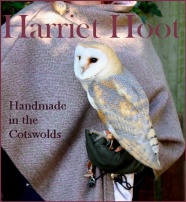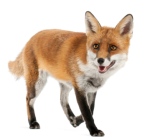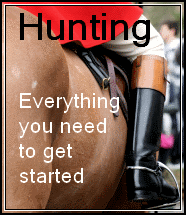Hunting Attire
Hunting Attire
 You and your horse’s turnout are very important and all hunts have recommendations and guidelines for both appearance and safety on the hunting field. Whilst in many walks of life, individuality is encouraged, on the hunting field at best it is frowned upon and at worst you may be asked to leave. As a newcomer you may be able to get away with a less formal approach but seasoned hunters are expected to be in proper attire.
You and your horse’s turnout are very important and all hunts have recommendations and guidelines for both appearance and safety on the hunting field. Whilst in many walks of life, individuality is encouraged, on the hunting field at best it is frowned upon and at worst you may be asked to leave. As a newcomer you may be able to get away with a less formal approach but seasoned hunters are expected to be in proper attire.
The less correctly turned out should generally remain at the back of the field which may also be a safer place for the newbie!
Ratcatcher is considered informal dress and is usually worn during Autumn hunting. It may also be worn at informal meetings during the year.
There are few hunts that allow juniors to wear black or navy coats but most are required to wear tweed until they turn eighteen.
All hunts have their own guidelines so you should check with the Master or secretary on what is appropriate.
Hats, Boots, Whips and Body Protectors
Gentlemen may wear a top hat, a bowler or hunting cap, and ladies may wear a bowler or hunting cap, unless they are riding side saddle when a top hat may be worn. Safety helmets with harnesses are also acceptable but brightly coloured silks should be reserved for the racecourse. Children should always be in an ASTM safety helmet with harness and black cover. Riding hats with reflective strips on the front should be kept for show jumping.
For your own safety, your hat should fit well and stay in place in the highly unlikely event that you will have a fall. Ribbons on the back of hunt caps should always be sewn up unless you are professional hunt staff or a Master. Hair nets should be worn over long hair.
 Whilst back protectors are not visible in the many vintage hunting scenes, they have become a popular choice and may be worn inside or outside the jacket.
Whilst back protectors are not visible in the many vintage hunting scenes, they have become a popular choice and may be worn inside or outside the jacket.
Long black boots without tops (unless formal attire) should be worn. Children may also wear jodhpur boots but tall boots will generally offer more protection. Authentic looking rubber boots are acceptable.
Hunting whips or crops can be carried but not down your boot! They are extremely useful for opening gates and holding them open as well as dangling in front of your horse to guide hounds around them.
Accessorizes
If you are carrying additional items such as saddle flasks, fence tools, camera cases etc. they should be unobtrusive and made of leather.
Bling jewellery and perfume are generally deemed inappropriate. Although faux stock ties are generally permissible, a full length stock is preferable both for the sake of appearance and, more significantly, in the event it is needed as a bandage or sling.
Stock pins should be plain without emblems etc.
Generally, the only decoration worn on a hunt coat is a poppy before Remembrance Sunday or a black arm band when in mourning, except Pony Club badges on children's hacking jackets.
Most of all you should be:
- Warm and dry
- Clean and smart
- Remember you are hunting in the countryside not exhibiting in the show ring
- Having fun!
Ladies
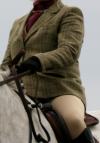
- Tweed coat or hacking jacket
- Natural coloured (not white) breeches.
- Shirt and coloured tie or ratcatcher shirt with collar and stock pin.
- Tattersall vest
- Brown leather gloves
- Brown or black field boots
- Hunt cap or safety helmet
Formal
- Black frock coat or Melton coat with plain black buttons
- Canary or Tattersall waistcoat
- White shirt with white stock tie and horizontal gold pin
- Buff or tan britches
- Wash, brown, black or string gloves
- Regular hunting spurs high on the heel
- Black boots without tops, tabs are sewn in but not sewn down.
 Black velvet hunting cap or safety helmet
Black velvet hunting cap or safety helmet
Gentlemen
- Tweed coat or hacking jacket
- Natural coloured (not white) breeches.
- Shirt and coloured tie
- Tattersall vest
- Brown leather gloves
- Brown or black field boots
- Hunt cap or safety helmet
Formal
- Black frock coat or Melton coat with plain black buttons
- Canary or Tattersall waistcoat
- White shirt with white stock tie and horizontal gold pin
- With a Melton coat, buff or tan britches. With a Black frockcoat, white breeches and boots with brown tops.
- Wash, brown, black or string gloves
- Heavy pattern hunting spurs high on the heel
- Black boots without tops, tabs are sewn in but not sewn down.
- Black velvet hunting cap or safety helmet
Juniors
- Tweed coat or hacking jacket
- Natural coloured (not white) breeches.
- Tall black boots or brown jodhpur boots.
- Shirt and coloured tie or ratcatcher shirt with collar
- Tattersall vest
- Black velvet hunting cap with harness or an ASTM safety helmet with harness and black cover.
Formal
- Black or dark coloured Melton coat with plain black buttons (some hunts allow juniors to wear black or navy coats but most require tweed until they turn 18)
- Canary or Tattersall waistcoat
- White shirt with white stock tie and horizontal gold pin
- Buff or tan britches or jodhpurs
- Wash, brown or black leather gloves
- Regular hunting spurs high on the heel
- ASTM safety helmet with harness and black cover.
Colors or Honors
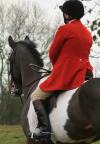 Colors is the term used to describe the hunt uniform or livery with the hunt color on the formal coat’s collar and buttons with the hunt insignia. You are only entitled to wear colors when granted by the Master. This is generally done to recognise ability and responsibility on the hunting field and support of the hunt outside the field.
Colors is the term used to describe the hunt uniform or livery with the hunt color on the formal coat’s collar and buttons with the hunt insignia. You are only entitled to wear colors when granted by the Master. This is generally done to recognise ability and responsibility on the hunting field and support of the hunt outside the field.
If you have been awarded colors then gentlemen generally change to a scarlet coat with the hunt colors on the collar and brass buttons with the hunt insignia. Ladies wear the hunt colors on the black coat’s collar and have the insignia on the black buttons. They may also have black patent leather tops on their dress boots. Small brass buttons with the hunt insignia may also be worn on the waistcoat.
The number of buttons also has significance
- 3 buttons - normal hunt subscriber
- 4 buttons – Master
- 5 buttons - huntsman and whippers-in (hunt staff)
Colors and scarlet coats are worn on a formal day when hunting with your hunt’s hounds. Wearing colors is never assumed when hunting with another pack and visitors should wear black or seek permission from the host Master to wear their colors
In bad weather, such as torrential rain or freezing conditions, the Master may suspend the requirement for formal attire
Last Updated: September 2013










